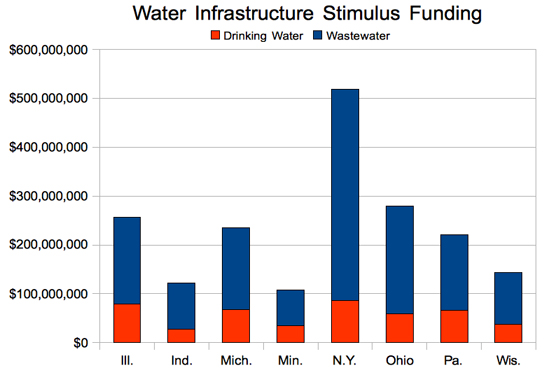 Jeff Gillies, gilliesj@msu.edu
Jeff Gillies, gilliesj@msu.edu
Great Lakes Echo
While many Michigan communities struggle with water problems, the state’s poorest city may still be sitting on 100-year-old wood water mains.
“If they’ve got the flu, you can imagine that we’ve got pneumonia,” said Marcus Robinson, president of Benton Harbor’s Consortium for Community Development.
Benton Harbor is one of hundreds of Great Lakes communities that could benefit from a $1.88 billion federal boost to the region’s state-run water project loan programs.
The federal economic stimulus package will funnel $6 billion through the Environmental Protection Agency into water projects nationwide. The Great Lakes states are in line for $1.4 billion for wastewater projects and another $450 million to improve municipal drinking water systems.
The EPA sent $432 million — the agency’s biggest grant ever — to New York’s sewer program on April 3. The state should see another $87 million for drinking water projects.
Michigan Gov. Jennifer Granholm has announced drinking water and wastewater projects eligible for a piece of the state’s $236 million allotment. That includes new water mains in Port Huron and sewer improvements in Detroit, Lansing and Benton Harbor.
Ohio will get $279 million and was accepting project applications through the state’s recovery Web site until March 13. Ohio Environmental Protection Agency spokeswoman Melissa Fazekas said that the agency has received applications for more than $4 billion worth of projects.
In early February, after the stimulus bill passed the House but before it passed the Senate, the Indiana Finance Authority published a list of 12 drinking water and wastewater projects that would be the first to get zero-percent interest loans.. When the bill passed it gave Indiana $122 million for water projects — around $40 million less than the state expected when the list was published.
Indiana’s list includes drinking water mains for Liberty, Madison and North Manchester and a $10 million wastewater treatment plant in Peru.
It’s not clear how much money Benton Harbor will get, but it will be a significant help, Robinson said. The sewer projects will put people to work in a city with a 17 percent unemployment rate.
Additional money from the Michigan Department of Transportation will give the city a chance to repave the roads and sidewalks that get dug up during construction, many of which are more than 50 to 75 years old.
“The sidewalks are so bad here that you can’t even plow them in the winter, so people end up walking in the streets,” Robinson said.

Here is the breakdown for the Great Lakes basin:
– Illinois: $256 million
– Indiana: $122 million
– Michigan: $236 million
– Minnesota: $107 million
– New York: $519 million
– Ohio: $279 million
– Pennsylvania: $220 million
– Wisconsin: $143 million
Jim, your best bet is to check the website of whichever agency handles the State Revolving Fund in each state. Here are lists of projects that got stimulus money in New York, for example:
Sewer projects: http://www.nysefc.org/home/index.asp?page=755
Drinking water projects: http://www.nysefc.org/home/index.asp?page=1015
How can you determine where the money went? What counties in NY? for example.
Pingback: Great Lakes Restoration Initiative funds cannot be spent on region’s ailing sewers | Great Lakes Echo
Funding for drinking water improvement is long overdue. Consider the following.
Waterborne disease is not restricted to developing countries. Morris and Levine (1995) attempted to estimate the annual waterborne disease burden in the United States of America and indicated that 560 000 people may suffer from a moderate to severe waterborne infection and that 7.1 million suffer from a mild to moderate waterborne infection each year.
Patterns of infection change over time and public health authorities can be been faced with newly discovered or emerging pathogens that may be able to overcome the many barriers of the water treatment and distribution systems (CDR, 1998).
There are more than 140 known microorganisms recognized as waterborne or water-based pathogens. The waterborne and water-based pathogens have emerged as important to health care because of the increase in the size of sensitive populations in the US which now comprise 25% of the population.
Ziggy Kozicki
Great Lakes Water Research Institute